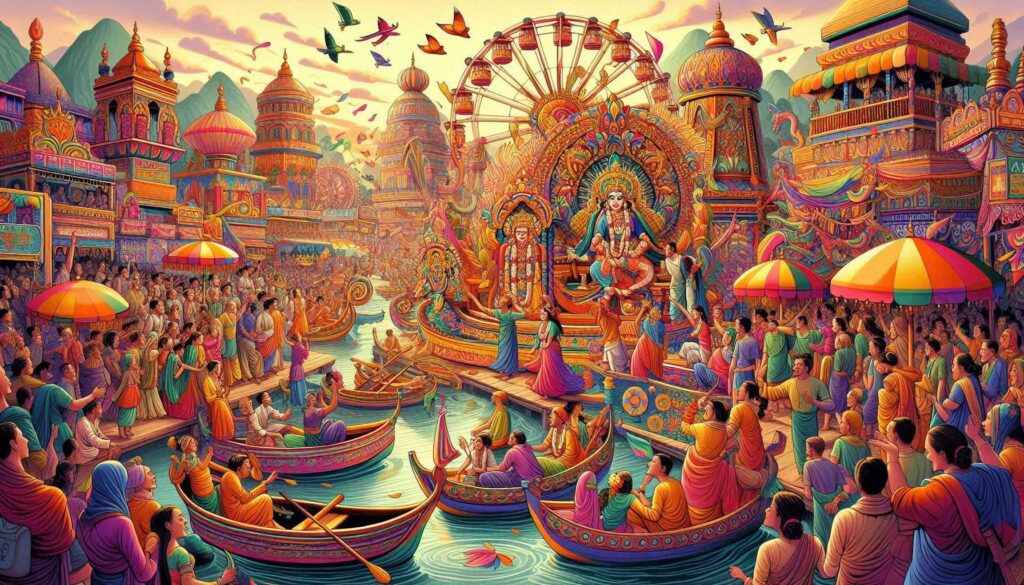Festivals in Odisha in November 2025
Odisha, known for its deep-rooted spirituality and cultural diversity, embraces a variety of festivals that reflect the region’s unique traditions, beliefs, and history. In November 2025, the state will be brimming with celebrations that range from solemn spiritual observances to lively cultural events. This month brings a blend of both well-known and regionally cherished festivals, each representing different aspects of Odia life, devotion, and heritage.
Read More About Hindu Philosophy
1. Kartik Purnima

Overview
Kartik Purnima, celebrated on the full moon day of Kartik (the eighth lunar month in the Hindu calendar), is one of the most sacred days in Odisha. It honors Lord Vishnu and celebrates the maritime history of the state.
Rituals and Traditions
- Boita Bandana: Devotees float miniature boats with lamps and flowers in rivers and ponds, a practice that commemorates Odisha’s ancient seafaring tradition with Southeast Asian countries.
- Temple Visits: Many people visit temples, particularly those dedicated to Vishnu and Shiva, and participate in rituals and prayers.
- Fairs and Community Gatherings: Colorful fairs and processions are organized, and devotees gather at riversides for communal worship and festivities.
Cultural Significance
Kartik Purnima is a reminder of Odisha’s maritime connections and a celebration of the divine, fostering a sense of pride in the state’s rich cultural history.
2. Bali Jatra

Overview
Bali Jatra, which translates to “A Voyage to Bali,” is a major festival held in Cuttack to honor Odisha’s historical trade with Bali, Indonesia. It’s one of the largest trade fairs in the region, attracting thousands of visitors.
Rituals and Traditions
- Boita Bandana Ritual: People float small paper or banana-leaf boats with lamps, commemorating the voyages made by ancient merchants.
- Trade Fair and Exhibitions: The festival includes a massive trade fair showcasing local handicrafts, textiles, and traditional food.
- Cultural Performances: Folk dances, music, and dramas are performed, reflecting Odisha’s cultural richness.
Cultural Significance
Bali Jatra celebrates the maritime legacy and economic heritage of Odisha, allowing people to reconnect with their historical roots and enjoy traditional arts and crafts.
3. Diwali (Balipadyami)

Overview
In Odisha, Diwali holds special importance as Balipadyami, a day dedicated to the legendary king Bali. This festival celebrates the spirit of generosity and the return of the noble king to earth.
Rituals and Traditions
- Lighting of Diyas: Families light lamps to invite prosperity and drive away darkness.
- Offering to Bali: Special prayers are offered, and homes are decorated with rangoli patterns and lights.
- Community Celebrations: People gather to share sweets, participate in rituals, and exchange good wishes.
Cultural Significance
Diwali as Balipadyami is unique to Odisha, celebrating the virtue of giving and highlighting the spiritual values associated with King Bali.
4. Prathamastami

Overview
Prathamastami is a family-centered festival celebrated in Odisha, honoring the eldest child in every household. It emphasizes the importance of the firstborn and blessings for health and longevity.
Rituals and Traditions
- Worship of Sathi Devi: Families perform rituals for Sathi Devi, the goddess of protection, to bless the eldest child.
- Special Food Preparations: Enduri Pitha, a rice cake wrapped in turmeric leaves, is prepared as a special treat.
- Blessings from Elders: Elders bless the eldest child, who wears new clothes and participates in the rituals.
Cultural Significance
Prathamastami celebrates family bonds, expressing the love and hopes for the firstborn while reinforcing respect and unity within the family.
5. Manabasa Gurubara

Overview
Manabasa Gurubara, observed on Thursdays in the month of Margashirsha, is dedicated to Goddess Lakshmi. This festival, unique to Odisha, involves worship at home and seeks blessings for prosperity.
Rituals and Traditions
- Home Decoration with Alpana (Jhoti): Intricate designs made from rice paste decorate floors and entrances, inviting the goddess into homes.
- Lakshmi Puja: Women offer prayers and traditional foods to Lakshmi, especially rice, symbolizing abundance.
- Storytelling and Folk Songs: Women recite the Lakshmi Purana, narrating stories of the goddess and the values she upholds.
Cultural Impact
Manabasa Gurubara reflects the simplicity and devotion of Odia households, reinforcing values of generosity, respect, and moral integrity.
6. Kalipuja

Overview
Kalipuja, the worship of Goddess Kali, is celebrated with great fervor, particularly in areas where Shakti worship is prominent. The festival seeks the goddess’s blessings for protection and strength.
Rituals and Traditions
- Kali Idol Worship: Idols of Kali are installed in shrines and public spaces, and special pujas are performed.
- Night-long Vigil: Devotees maintain a vigil through the night, praying and singing hymns dedicated to Kali.
- Offerings and Rituals: Offerings such as flowers, sweets, and even animal sacrifices (in some regions) are made to the goddess.
Cultural Significance
Kalipuja highlights the veneration of the fierce aspect of the divine feminine, acknowledging the strength and power inherent in nature.
7. Rasa Purnima
Overview
Rasa Purnima is celebrated in Odisha to commemorate the divine love of Lord Krishna with the Gopis of Vrindavan. This festival is observed with devotion, particularly in regions with a strong Vaishnavite presence.
Rituals and Traditions
- Krishna Idol Worship: Beautifully adorned idols of Krishna are worshipped with devotion and joy.
- Dances and Songs: Traditional dances, re-enacting the Ras Leela of Krishna, are performed, capturing the spirit of divine love.
- Community Gatherings: Devotees come together to offer prayers, sing devotional songs, and dance in celebration.
Cultural Impact
Rasa Purnima brings communities together, reinforcing the themes of love, devotion, and divine play (lila) that are central to Vaishnavism.

